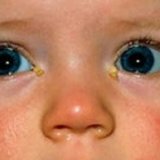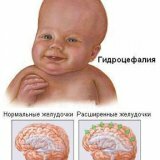Hypertensive syndrome in children

Hypertensive syndrome is a neurological pathology - it is an increase in intracranial pressure, most often associated with impaired blood flow. The brain is washed by a cerebrospinal fluid called "cerebrospinal fluid".There is balance between the development of the CSF and its reverse absorption. Under the influence of various causes, this balance is violated. Hypertensive syndrome is usually a consequence of intrauterine hypoxia or birth trauma. To the causes of the development of hypertensive syndrome in children, it is also possible to include the following factors: deep prematurity, intracranial hemorrhage, ischemic brain damage, congenital malformations of the brain, intrauterine infections and others.
In older children, hypertension syndrome manifests as a headache of a bursting nature. In the initial period, the pain in the head can be paroxysmal, it usually manifests itself in the morning hours and intensifies after physical exertion. Then the headache becomes permanent and periodically strengthens.
In young children with hypertensive syndrome, there is restless behavior, periodic crying, sleep disturbance. At the peak of the headache, nausea and vomiting can be observed, resulting in short-term relief. There is also increased sweating, changes and fluctuations in the body temperature of the child. Such children are meteorological dependent, that is, they react to any changes in the weather.
It should be remembered that the presence of increased intracranial pressure in a baby will not be reflected in the future on his physical and mental development. Such children will not have motor or intellectual disorders.
When a child is examined, a neurologist can see a translucent network of subcutaneous veins on the temples and forehead. It is possible to enlarge a large fontanel, a small fontanel and seams between the bones of the skull can be opened. The circumference of a baby's head can grow faster than it is by the age. A frequent symptom of hypertensive syndrome is Gref's symptom, in which a strip of protein can be seen above the iris of the eyes.
The diagnosis is confirmed by neurosonoscopy and examination of the fundus, on which stagnant phenomena are detected.
Treatment of children with hypertension syndrome
Young children with hypertensive syndrome should be observed and treated in a pediatric neurologist up to 1 year, and according to indications - and longer. Based on the severity of hypertensive syndrome and its clinical manifestations, the doctor prescribes treatment. It can be medicines that remove excess cerebrospinal fluid from the brain( glycerol, potassium citrate, triampur, diacarb), or drugs that bring the vascular tone back to normal( escusan).With a sedative purpose, infusions of herbs( mint, valerian, motherwort, horsetail, sage) are prescribed.
In order to help restore the nervous system of the baby, you need to make sure that he rarely cry, sleep and eat at the same time, walk more often outdoors, and also protect him from various infections.
In most young children, after treatment, intracranial pressure returns to normal by six months - one year, but it can persist for life.
Older children with hypertensive syndrome should consult a pediatric neurologist at least twice a year. Obligatory examination of the fundus( at least once or twice a year) and radiographic examination of the skull( once every two or three years) are mandatory. Children who have suffered a craniocerebral injury, as well as inflammatory diseases of the brain and its membranes, are subject to dispensary observation.



